Sommersemester 2020, Malerei , Bildhauerei , Bühnen- und Kostümbild , MA Kunsttherapie , MA Raumstrategien , Theorie und Geschichte
SOCIAL SCULPTURE vs CHALLENGED PUBLIC SPACES
bildhauerei@kunsthochschule.berlin
June 27 - July 20 2020
weißensee university of art berlin
at Lobe Block, Böttgerstrasse 16, 13557 Berlin
Organizers: Hannes Brunner, Ulrike Mohr, and Olivia Reynolds
Tutor: Marié Nobematsu-Le Gassic
with:
Fadi Aljabour, Friedrich Andreoni, Dorna Dibaj, Nikolas Eckl, Katya Quel Elizarova, Ivanna Heredia, Daniel Hölzl, Tomer Houlmann, Gabriela Lesmes, Marié Nobematsu-Le Gassic, Yunosuke Ozawa, Belen Resnikowski, Susanne Weber-Lehrfeld
How do we develop a social sculpture if discussions are just digital? We increasingly see our own faces fixed as images, through teleconferencing. This was the main mode of communication during this semester and the organization of this intervention. In their book Mille Plateau, Gilles Deleuze and Félix Guattari have dedicated a chapter to the "creation of the face", in which they set the face as a schema apart from the idea that the "visualization" of the most diverse phenomena of the natural and technical environment is a project of making similarities and anthropomorphization. In response, some interventions have been created as a sort of flowing dramaturgy for the next three weeks:
On the ramp we find a small bust of Albert Einstein. Above it is a suspended plumb bob (Tomer Houlmann). Curiosity is aroused suggesting perhaps how an idea can haunt a theorist when it becomes a reality beyond their control. Perhaps these words Einstein wrote might provide some clues: "I would rather choose to be a plumber or a peddler in the hope to find that modest degree of independence still available under present circumstances.”. Fadi Aljabour’s work „Missing God“ shows large footprints of the length of 97 cm each on acrylic and soil in golden color. They refer to similar footprints in Ain Dara temple, Syria. It is said that they are symbols of the presence of the gods in this place. Nearby, we hear a whisper without melody, a white noise – the tactful rhythm of the Italian resistance song Bella Ciao (Friedrich Andreoni). With the removal of the melodic singing, the memory of human belonging begins to potentiate, as perhaps has been felt by many in isolation, triggered by lockdown. Katya Quel Elizarova shows a poetic video projected into the area of sight of a simulated humanoid being, covered by VR glasses. It shows planets, which might have capacities for the conditions of life. Abstract computer graphics refer to scientific visualizations, running texts provide technical informations, while a message to earthlings resounds to an already dead civilization. A monitor nearby shows a video recording of „Suspended Oscillation“ (Belen Resnikowski and Susanne Weber-Lehrfeld), a blindfolded performance, that aims to connect to the instinct, trusting on the inner orientation of memory, that explores the connection between the inside and the outside world. Aside of it Belen Resnikowski shows her Video Art Documentation (11:00 min) „Stream of Consciousness“, which is a performative writing, exploring the fear of loss, the loss of oneself and the loss of someone; a reflection about the color blue, the immaterial world and the silence inside the void. On the ramp we find a mirrored acrylic plate, one of two objects by Yunosuke Ozawa. The form is based on Fenghuang (鳳凰) from Chinese mythology, which is known as a phoenix, but remains abstract in traditional patterns. The mirror is positioned to reflect the sunlight at 2pm onto the second object. Gabriela Lesmes draws tension with a large slingshot mounted across the ramp. With a hint of normalcy, we find a large bowl-like vessel on the ground (Nikolas Eckl), where a campfire is lit but without fire. A number of LED lights appear to communicate with each other within, flickering at dusk.
Beginning on June 27th. Several short-term / time-based interventions take place over the entire three-week period. Marié Nobematsu-Le Gassic releases a blue dust protection net (Staubschutznetz) from the top of the building to cascade along the façade and collect in a soft pile on the ramp. There, she immerses herself in it with her movements––simultaneously holding and folding the façade. Daniel Hölzl suspends two vertical grids that counter the horizontal floor slabs and match the size of the building’s windows. Nearly 8,000 threaded elements that resemble polystyrene packing chips are hung as two chain-like curtains. When the chips––made of 100% biodegradable nontoxic material––touch a film of water, the installation will slowly begin to dissolve itself. Further back dangles a large cylindrical bag filled with colored sand (Ivanna Heredia). A small hole is made and a thin stream of sand descends like an hourglass. The bag empties, accelerated by punches from the visitors, leaving its signature on the floor. The perception of time: conscious movements interspersed with collective imagination address our discussions online. On the deck, Dorna Dibaj refers to John Cage’s Indeterminacy of Performance. Real. Emotion. Memory. During a one and a half hour performance, she writes with spatial interactions on site, where a real fictional text is projected with light.
Normally we experience the physical outside space as a collective. But for several decades now, it has been capitalized into picturesque, fragmented forms for the digitalized trading place and excluded from ecological design responsibility. As Bruno Latour writes: “What was a virtuality becomes an exciting project for both the largest and the smallest minds: knowledge means knowing from the outside. Everything must be seen as if by Sirius––a Sirius of imagination to which no one has ever had access."
The social sculptures will be open to the public between June 27th through July 20 2020, unless otherwise stated.
Opening ceremonies will be celebrated Saturday June 27th and Sunday June 28th, 4 pm - 8 pm. Finissages will be performed Saturday July 18th and Sunday July 19th, 4 pm - 8 pm. The project is also available on the website of the Rundgang 2020 Weißensee Kunsthochschule Berlin. It is part of this year's tour, which, in addition to the online presentations, shows projects in the urban environment.
++++++++
dt
Wie entwickeln wir eine soziale Skulptur, wenn Diskussionen nur digital stattfinden? Wir sehen unsere eigenen Gesichter zunehmend durch Telekonferenzen. Dies war die Hauptkommunikationsart während dieses Semesters und die Organisation dieser Intervention. Gilles Deleuze und Félix Guattari haben in ihrem Buch Mille Plateau ein Kapitel der "Schöpfung des Gesichts" gewidmet, in dem sie das Gesicht als Schema von der Idee abheben, dass die "Visualisation" ein Projekt zur Herstellung von Ähnlichkeiten und zur Anthropomorphisierung der verschiedensten Phänomene des natürlichen und technischen Umfelds darstellt. Als Antwort darauf sind einige Interventionen als fließende Dramaturgie entstanden und nun über einen Zeitraum von drei Wochen sichtbar:
Auf der Rampe: Wir entdecken eine kleine Büste von Albert Einstein. Darüber schwebt ein Senklot (Tomer Houlmann). Die Neugier wird geweckt, wie eine Idee einen Theoretiker verfolgen kann, wenn sie außerhalb ihrer Kontrolle Wirklichkeit wird. Vielleicht könnten die Worte, die Einstein schrieb, einige Klärung bieten: "Ich würde mich lieber dafür entscheiden, Klempner oder Hausierer zu sein, in der Hoffnung, dass unter den gegenwärtigen Umständen noch ein bescheidenes Maß an Unabhängigkeit vorhanden ist." Fadi Aljabours Werk „Missing God“ zeigt große Fussabdrücke, je 97 cm lang, auf Acryl und Erde in goldener Farbe. Sie beziehen sich auf ähnliche Abdrücke im Ain Dara-Tempel in Syrien. Von ihnen wird gesagt, dass sie Symbole für die Gegenwart der Götter an diesem Ort sind. Gleich daneben hören wir die Arbeit von Friedrich Andreoni: Ein Flüstern ohne Melodie, ein weißes Rauschen - der taktvolle Rhythmus des italienischen Widerstandsliedes Bella Ciao. Mit der Beseitigung des melodischen Gesangs beginnt sich die Erinnerung an etwas Menschliches zu potenzieren, das vielleicht viele in der Isoliertheit der Quarantänen empfunden haben. Katya Quel Elizarova zeigt ein poetisches Video, das in den Brillenausschnitt eines simulierten humanoiden Wesens projiziert wird und normalerweise von einer VR-Brille bedeckt ist. Es zeigt Planeten, welche die Voraussetzung für Leben bieten. Abstrakte Computer-Grafiken beziehen sich auf wissenschaftliche Visualisierungen, laufende Texte liefern technische Informationen, während eine Botschaft an die Erdbewohner einer bereits toten Zivilisation weitergegeben wird. Auf einem anderen Monitor zeigen Belen Resnikowski und Susanne Weber-Lehrfeld eine Videodokumentation von „Suspended Oscillation“, einer Performance mit verbundenen Augen, die darauf abzielte, instinktiv der innerer Ausrichtung des Gedächtnisses zu vertrauen und so die Verbindungen zwischen Innerem und Äusserem zu erforschen. Daneben zeigt Belen Resnikowski ihr künstlerisches Video (11:00 min) „Stream of Consciousness“. Es ist ein performatives Skizzieren, das die Angst vor Verlust, den Verlust von sich selbst und den Verlust von jemandem untersucht. Eine Reflexion über die Farbe Blau, die immaterielle Welt und die Stille in der Leere. Auf der Rampe finden wir eine verspiegelte Acrylplatte, eines von zwei Objekten von Yunosuke Ozawa. Die Form basiert auf Fenghuang (鳳凰) aus der chinesischen Mythologie, die als Phönix bekannt ist, aber in traditionellen Mustern abstrakt bleibt. Der Spiegel ist so positioniert, dass das Sonnenlicht um 14 Uhr auf das zweite Objekt reflektiert wird. Gabriela Lesmes spannt eine übergrosse Steinschleuder über die Rampe. Von Nikolas Eckl finden wir daneben ein normales Lagerfeuergefäss. Allerdings ohne Feuer, aber mit einer Anzahl von LED-Lichtern, die in der Dämmerung aufzuflackern und miteinander zu kommunizieren scheinen.
Ab dem 27.Juni 2020: verschiedene kurzfristige / zeitbasierte Interventionen finden während drei Wochen statt. Marié Nobematsu-Le Gassic lässt ein blaues Staubschutznetz entlang der Fassade herunterfallen, das sich auf der Rampe in einem weichen Haufen sammelt. Dort taucht sie mit ihren Bewegungen in das Netz ein. Aus dem Off kommentiert eine Stimme, während sich ihre Gesten und Bewegungen in das Netz hineingeben. Ab dem 27.Juni finden über den gesamten Zeitraum von drei Wochen mehrere kurzfristige / zeitbasierte Interventionen statt. Daniel Hölzl hängt zwei vertikale Gitter auf, die den horizontalen Betonplatten entgegenwirken und der Größe der Gebäudefenster entsprechen. Fast 8000 aufgefädelte Teilchen, eine Alternative zu Polystyrol-Packchips, wirken wie zwei Kettenvorhänge. Die Chips bestehen aus wasserlöslichem, 100% biologisch abbaubarem, ungiftigem Material. Durch den Kontakt zu Wasser löst sich die Installation langsam auf. Weiter hinten baumelt eine große zylindrische Tasche von Ivanna Heredia, die mit farbigem Sand gefüllt ist. Ein kleines Loch wird unten eingeschnitten, womit ein dünner Sandstrahl heraus rieselt, wie aus einer Sanduhr. Die Tasche leert sich, auch durch Schläge der Besucher, und hinterlässt Spuren am Boden. Es ist eine Wahrnehmung der Zeit: bewusste Bewegungen, durchsetzt mit kollektiver Vorstellungskraft aus den Online-Diskussionen. Auf der Rampe bezieht sich Dorna Dibaj auf John Cages „Indeterminacy of Performance“. Echtheit, Emotion. Erinnerung. Während einer eineinhalbstündigen Performance schreibt sie in räumlichen Interaktionen vor Ort einen fiktiven Text, der durch Laser projiziert wird.
Normalerweise erleben wir den physischen Außenraum im Kollektiv. Aber seit einigen Jahrzehnten nehmen die zunehmenden Bestrebungen überhand, diesen den digitalisierten Handelsplätzen einzuverleiben, mit illusionistisch fragmentierten Formen auszuschmücken und von der Verantwortung eines ökologischen Handelns auszuschliessen. Bruno Latour schreibt: „Was eine Virtualität war, wird für den größten und den kleinsten Geist zu einem spannenden Projekt: Wissen bedeutet Wissen von außen. Alles muss wie von Sirius gesehen werden - ein Sirius der Phantasie, zu dem noch niemand Zugang hatte. "
Sofern nicht anders angegeben, ist die soziale Skulptur bei Lobe zwischen dem 27.Juni und dem 20.Juli 2020 zugänglich. Die Eröffnungsfeierlichkeiten finden am Samstag, 27. Juni, und Sonntag, 28. Juni, von 16.00 bis 20.00 Uhr statt. Die Finissagen werden am Samstag, 18. Juli, und Sonntag, 19. Juli, von 16.00 - 20.00 Uhr stattfinden. Das Projekt ist auch auf der Website des Rundgang 2020 Weißensee Kunsthochschule Berlin verfügbar. Es ist Teil der diesjährigen Tour, die neben den Online-Präsentationen auch Projekte im städtischen Umfeld zeigt.
++++
TIMELINE
Timeline
_______________________________________
27 June 24/7 until 20 July
Fadi Aljabour
Friedrich Andreoni
Ivanna Heredia
Tomer Houlmann
Gabriela Lesmes
Belen Resnikowski*
Susanne Weber-Lehrfeld
_______________________________________
temporary works
30 June
4-8pm
Daniel Hölzl
_______________________________________
04 July
2pm–late
Yunosuke Ozawa
Nikolas Eckl
_______________________________________
06 July
2-6pm
group critique
3-5pm
Marié Nobematsu-Le Gassic**
_______________________________________
10 July
7pm–late
Katya Quel Elizarova
_______________________________________
11 July
9pm–late
Dorna Dibaj
_______________________________________
13-17 July
mural painting
Katya Quel Elizarova
_______________________________________
Rundgang
(virtually provided by
Weißensee Academy of Art Berlin)
17–19 July
_______________________________________
17–20 July
5-8pm
Marié Nobematsu-Le Gassic**
_______________________________________
18 July
4pm
Ivanna Heredia
7pm–late
Katya Quel Elizarova
_______________________________________
20 July
finissage
_______________________________________
*video work in Baldon during opening hours
**performance, weather permitting
Projekt-Fächer Malerei, Bildhauerei, Bühnen- und Kostümbild, MA Kunsttherapie, MA Raumstrategien, Theorie und Geschichte
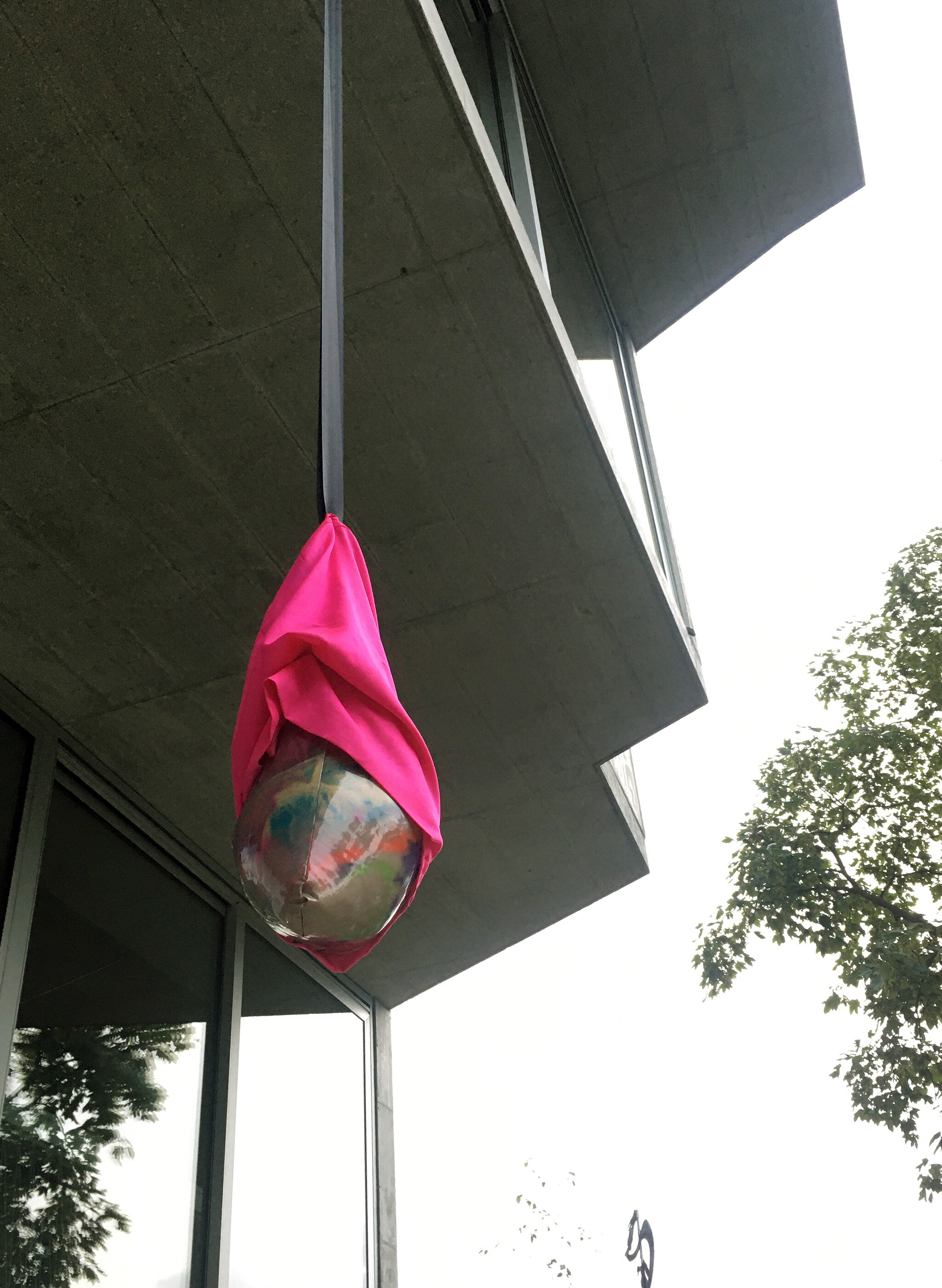
A large cylindrical bag is filled with colored sand (Ivanna Heredia). A small hole is made and a thin stream of sand descends like an hourglass. The bag empties, accelerated by punches from the visitors, leaving its signature on the floor
Alle Rechte vorbehalten
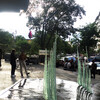
Bitte Lizenz eintragen!
Daniel Hölzl suspends two vertical grids that counter the horizontal floor slabs and match the size of the building’s windows. Nearly 8,000 threaded elements that resemble polystyrene packing chips are hung as two chain-like curtains. When the chips––made of 100% biodegradable nontoxic material––touch a film of water, the installation will slowly begin to dissolve itself.
Keine Lizenz
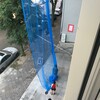
Bitte Lizenz eintragen!
Marié Nobematsu-Le Gassic releases a blue dust protection net (Staubschutznetz) from the top of the building to cascade along the façade and collect in a soft pile on the ramp. There, she immerses herself in it with her movements––simultaneously holding and folding the façade.
Keine Lizenz
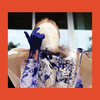
Bitte Lizenz eintragen!
Keine Lizenz
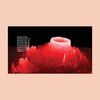
Bitte Lizenz eintragen!
Keine Lizenz
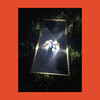
Bitte Lizenz eintragen!
Keine Lizenz